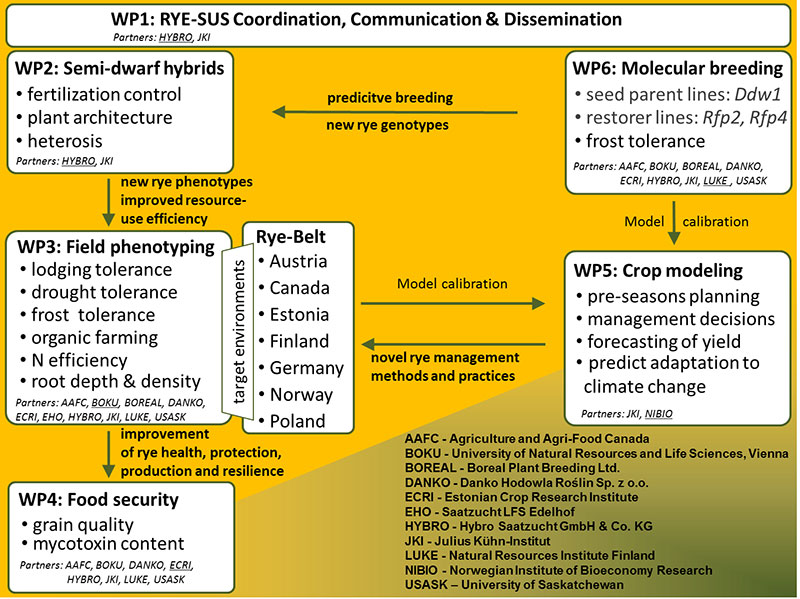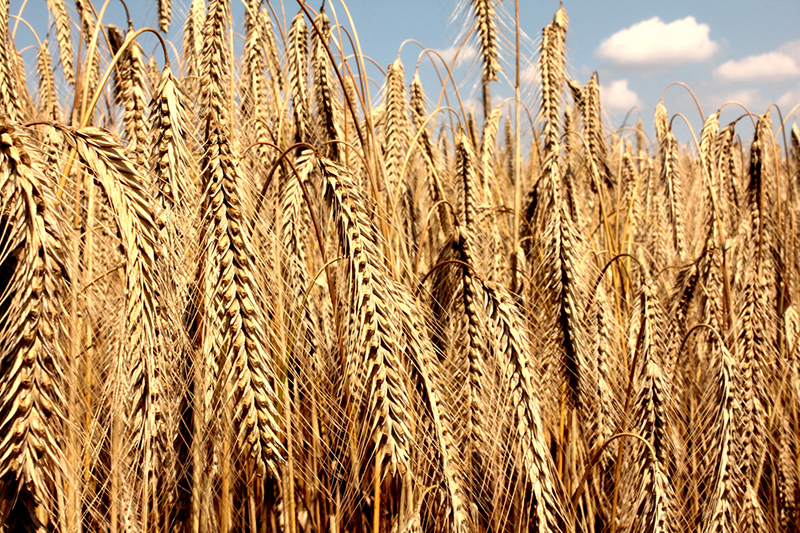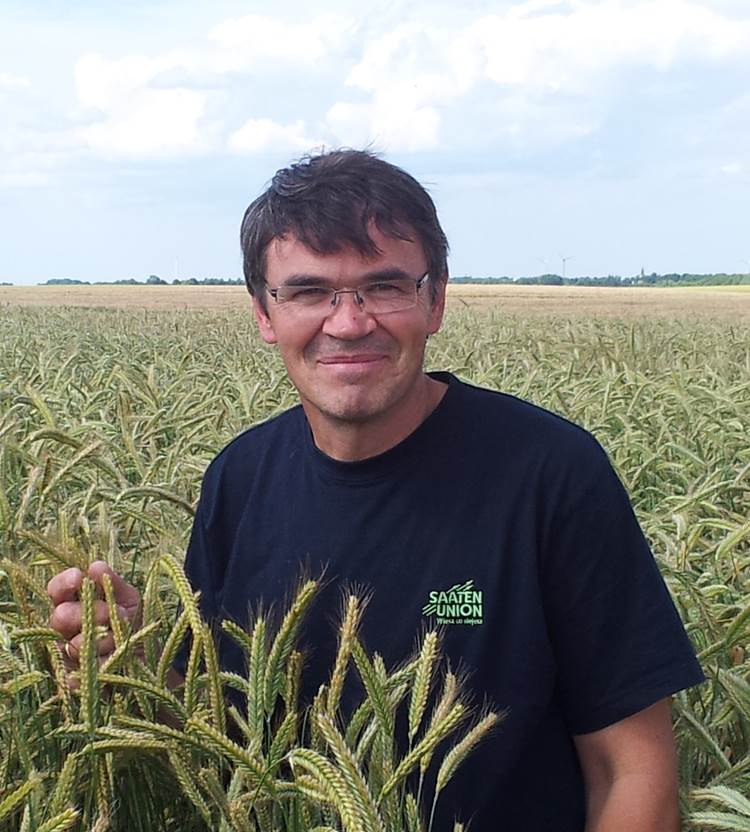Development of lodging-resistant and climate-smart rye – a contribution to a sustainable cereal production in marginal environments

Source: Bernd Hackauf
European cereal production experiences an ongoing intensification and specialisation on wheat and barley at the expense of minor cereals including einkorn, emmer, oat, rye and spelt. This specialisation leads to continuous loss in agricultural biodiversity and marginalisation of traditional land management systems. Rye is the only cross-pollinated small-grain cereal, which results in a unique complexity concerning the genetic improvement of rye and underlines the need for rye-specific research concepts.

Source: Bernd Hackauf
The overall goal of RYE-SUS is to develop, test and model gibberellin (GA)-sensitive semi-dwarf rye with optimized harvest index, improved lodging resistance, high yield potential and drought tolerance for a sustainable intensification including marginal production environments. The systematic exploitation of heterosis together with a genetically optimized allocation of dry matter to the grain offers a solution to create a sustainable food future by 2050 without using more land while lowering emissions. This approach is substantially different from current methods of genetic improvement of rye and wheat in a changing climate.
We make use of Twitter (https://twitter.com/RYE_SUS) for the timely dissemination of project-related information in WP1. Furthermore, the projects website (http://www.rye-sus.eu/) has been established as the major communication and dissemination tool providing background information, activities, benefits and outcomes of our research.
We used 3 semi-dwarf genotypes as well as their near-isogenic tall counterparts as seed parents, that have been developed in a pre-funding phase, and the so called Pampa CMS as a natural, reliable, environmentally friendly and inexpensive hybridization system to develop 48 GA-sensitive semi-dwarf prototypes - for the first time ever - and their 48 near-isogenic tall counterparts in WP2. The genetic make-up of these hybrids enables to minimize the risk of ergot infestation. In addition, we have successfully crossed 13 open pollinating cultivars with an inbred-line carrying Ddw1 for the genetic improvement of lodging tolerance and resource-use efficiency in random mating populations with shorter developmental cycles. The RYE-SUS field phenotyping platform has been successfully established in WP3 and used to evaluate 24 standard cultivars including grain quality parameters in WP4.
In WP5, we have conducted a partial life cycle assessment from cradle to farm gate considering all material and energy flows throughout rye and wheat production processes. Based on almost 40.000 historical observations from more than 100 locations throughout Germany during 1983-2019 we could demonstrate, that the carbon footprint (CFP), i.e. the greenhouse gas (GHG) emissions per unit harvest product of rye is generally smaller than that of wheat (figure 1). Furthermore, hybrids had higher yields and GHG emissions per unit land but lower CFP as compared to population varieties in rye. Based on the vast data set, more than 1000 cultivar specific crop model files were prepared to calibrate the DSSAT NWheat model and adapt it to rye.
The recently released rye reference genome sequence facilitates novel downstream applications at the single-gene level with unprecedented precision. In WP6, we have conducted an in-depth characterization of genes beyond the CBF regulatory hub residing at the Fr-R2 locus and identified 34 previously unknown genes significantly associated with winter field survival.

Source: Franz Joachim Fromme
Dr Franz Joachim Fromme
HYBRO Saatzucht GmbH & Co. KG, GERMANY
Email: fromme@hybro.de
Dr Bernd Hackauf
Julius Kühn-Institut, Institute for Breeding Research on Agricultural Crops, GERMANY
Prof Heinrich Grausgruber
University of Natural Resources and Life Sciences, Vienna Plant Breeding, AUSTRIA
Dr R. James Larsen
Agriculture and Agri-Food Canada, Lethbridge Research and Development Centre, CANADA
Dr Ilmar Tamm
Estonian Crop Research Institute, Jõgeva plant breeding, ESTONIA
Dr Teija Tenhola-Roininen
Natural Resources Institute Finland, Production systems, FINLAND
Dr Karol Marciniak
Danko Hodowla Roślin Sp. z o.o. Zakład Hodowli Roślin Choryń, POLAND
Mrs Elisabeth Zechner
Saatzucht LFS Edelhof, Plant breeding, AUSTRIA
Dr Anne Kari Bergjord Olsen
Norwegian Institute of Bioeconomy, Research Department of Grain and Forage Seed Agronomy, NORWAY
Dr Merja Veteläinen
Boreal Plant Breeding Ltd, FINLAND
Prof Ravindra N. Chibbar
University of Saskatchewan, Department of Plant Science, CANADA
2022
Båga, M., Bahrani, H., Larsen, J., Hackauf, B., Graf, R.J., Laroche, A., and Chibbar, R. N. (2022). Association mapping of autumn‑seeded rye (Secale cereale L.) reveals genetic linkages between genes controlling winter hardiness and plant development. Scientific Reports, 12, 5793.
Laidig, F., Feike, T., Klocke, B. Macholdt, J., Miedaner, T., Rentel, D., and Piepho, H. P. (2022). Yield reduction due to diseases and lodging and impact of input intensity on yield in variety trials in five cereal crops. Euphytica, 218, 150.
Hackauf, B., Siekmann, D., and Fromme, F. J. (2022). Improving Yield and Yield Stability in Winter Rye by Hybrid Breeding. Plants (Basel, Switzerland), 11(19), 2666.
Riedesel, L., Laidig, F., Hadasch, S., Rentel, D., Hackauf, B., Piepho, H.-P., and Feike, T. (2022).
Breeding progress reduces carbon footprints of wheat and rye. Journal of Cleaner Production, 377, 134326.
2021
Laidig, F., Feike, T., Klocke, B., Macholdt, J., Miedaner, T., Rentel, D., and Piepho, H. P. (2021). Long-term breeding progress of yield, yield-related, and disease resistance traits in five cereal crops of German variety trials. TAG. Theoretical and applied genetics. Theoretische und angewandte Genetik 134 (12), 3805–3827.
2019
Feike, T., Shawon, A. R., Bergjord Olsen, A., Waalen, W., Harvie, J. Haikka, H., Tupits, I., Tamm, I., Kottmann, L., Schittenhelm, S., Tenhola-Roininen, T., Zechner, E., Wiesner, F., Hanek, M., Niewinska, M., Siekmann, D., Fromme, F., Baga, M., Chibbar, R., and Hackauf, B. (2019). Development of lodging-resistant and climate-smart rye – a contribution to a sustainable cereal production in marginal environments. 10.13140/RG.2.2.25117.05609.
Hackauf, B., Shawon, A. R., Tsvetkova, N., Plieske, J., Miller, J., Ragupathy, R., Haikka, H., Maninnen, O., Tupits, I., Tamm, I., Tenhola-Roininen, T., Tanhuanpää, P., Laine, A., Hanek, M., Banaszak, K., Niewińska, M., Siekmann D., Zechner, E., Wieser, F., Bergjord Olsen, A. K., Waalen, W., Kottmann, L., Schittenhelm, S., Båga, M., Chibbar, R. N., Feike, T., Voylokov, A. V., F. J. Fromme, and Grausgruber, H. (2019). RYESUS: a transnational approach to support sustainable grain production in changing environments. Vereinigung der Pflanzenzüchter und Saatgutkaufleute Österreichs, 70, 61-69. BOKU-University of Natural Resources and Life Sciences, Vienna.
Project webpage: https://www.rye-sus.eu/
Twitter: https://twitter.com/RYE_SUS